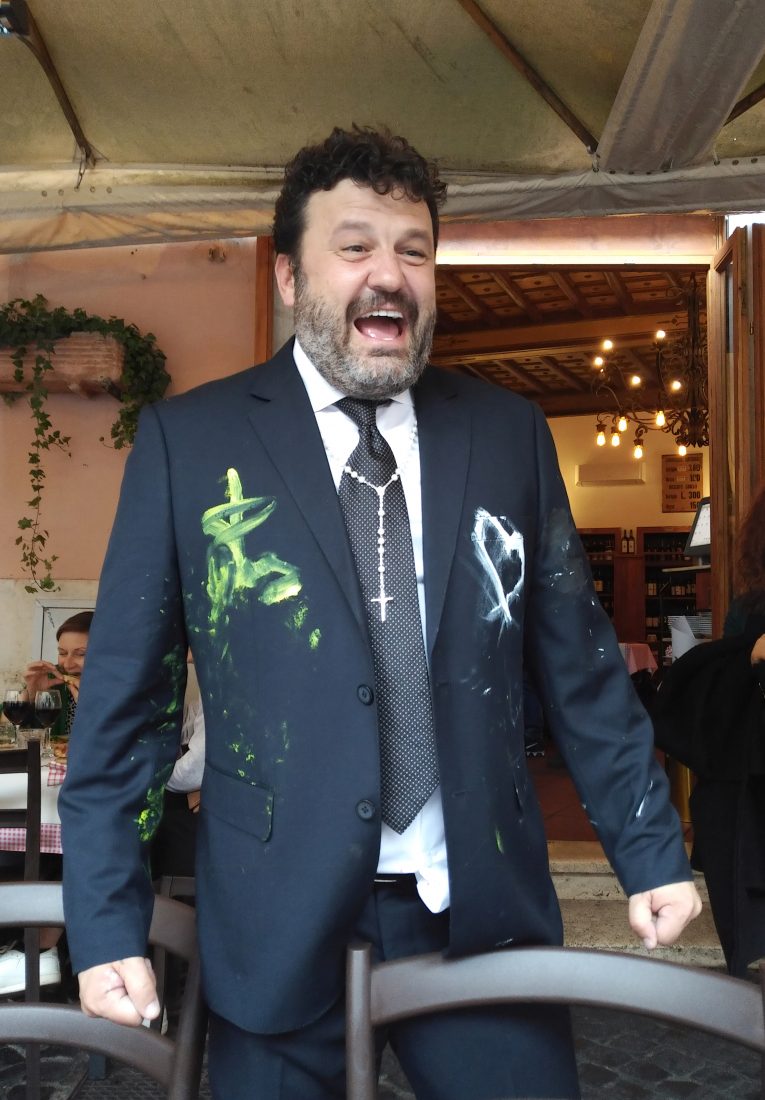By R. Couri Hay
Young Artists / Old School
Artist Domingo Zapata was honored at the Brooklyn Borough President’s Latino Heritage Celebration where he received the Most Influential Artist of The Year Award. The theme of the event is Young Artists/Old School and Domingo gave the keynote speech. Zapata has also created the illustrations for The Lonely Princess by Marie Ferraro from Lightswitch Learning, which comes out in time for the holidays in November. The book is about the power of friendship, generosity, and respect for the differences between people.
“Life is a Dream”
Domingo’s 15-story mural that wraps around the One Times Square. Features his mantra, “Life is a Dream” amidst flowers, flamingos and polo ponies. The artist said, “For me, it is an honor to be part of the story by creating Life Is a Dream, the largest mural in New York. I want to convey this message to people from all over the world who visit Times Square and who can enjoy and get to know my art.” The mural will be on view through January 1st.

Success, Contrast & the Future of Patronage
Zapata’s early impressions as an artist, coupled with several high-profile clients, first cultivated a reputation as an artist du jour. But after 15 years and creating a portfolio of art worth over $40 million, the Spaniard’s ever-increasing success – and the artistic vision underlying it – continues to paint a decidedly different picture.
For years, Domingo Zapata has been, in a word, busy.
It’s not just the paintings, which for the last decade have required perpetual work to keep any amount of inventory. It’s not the increasing number of sculpture and mural commissions that he fulfills or the expanding social media input. Nor is it his many exhibitions or the myriad number of collectors and clients, including Johnny Depp, Leonardo DiCaprio, Diana Picasso, the Missoni Family, and investment bank Goldman Sachs.
Instead, it’s what Zapata has been doing with his own time. Whether it be collaborations with global figures such as Alejandro Sanz, designing clothes for his fashion shows, donating artwork to innumerable charity events, writing a novel, painting with Pope Francis, or serving as a guest speaker at the United Nations to advocate for art education, Zapata has done it all.
Pope Picture
The resulting image is in stark contrast to the one that Zapata’s earliest critics predicted – that of an “artist to the stars.” But Zapata’s outlook and ascent have been remarkably consistent for the past fifteen years – the duration of his career as an artist – and the predilections of the past have been unraveled year by year, painting by painting, achievement by achievement.
As the artist himself notes, his works “contrast between the past and present, and try to make the work say something about the future.” It’s fitting, then, that Zapata himself is one such contrast, in art as in life; and with a past not steeped in fine art, but rather, in humble beginnings on the Spanish island of Mallorca.
Zapata’s Early Years
Had Zapata ambled up to a younger version of himself on Mallorca in the early 1980s, he would have likely found himself back in the garage his father worked in. And even then, it would not have been surprising to see him with paintbrush in hand. “I always loved to paint,” Zapata notes. “It’s something I was obsessed with since I was a kid. We had a car shop, and my dad fixed and painted cars, and my mom was a painter. We lived on top of the shop, so every day I lived with the paint and the fumes. The environment I grew up in was one with a creative family.”
But when it came to painting full-time, Zapata – who graduated from American University with a degree in political science – was at first more pragmatic, especially after his move to New York City in 1999, where the art scene was particularly intimidating. “Moving to New York, I never thought I had a chance. I came from this humble background, and I didn’t even know where to start. I took the first job that was available, to survive, and in those days, the jobs were in finance.”
For the next ten years, he worked in corporate, painting in his home when he could. That is, until one day in 2005, when a friend, contractor Michael Borrico, took an interest in a picture of a polo horse that Zapata had painted and placed in his office.

“This friend of mine came by our office and he said, ‘Oh, I love that painting, I’d love to show it to a friend of mine,’ Zapata recollects. “It was a painting of a polo horse. And I said to him ‘I did it.’ And he’s like, ‘I can’t believe you did that!’ And I said, ‘Look, I have a studio in my house; it’s a hobby. I do this.’”
Convinced he had found talent, Borrico organized a dinner and exhibition at his house, where Zapata’s work gained its first critical recognition. Various gallery representatives bought paintings, and the friend that Borrico had mentioned so casually in the office turned out to be none other than billionaire George Soros, who made a purchase of a polo painting titled “Blue Horse.”
The feedback was overwhelmingly positive. “They all motivated me to dedicate myself to art,” Zapata said. “I quit my job and started painting. I was working in the corporate world for more than ten years, leaving a job where you were making some money. But I thought, if I don’t do it now, in my early thirties, when am I going to do it? So I went and I said, ‘fuck it, I’m going to go ahead and do it.’ And thank God it worked!”
Asked if this strange road to the beginning of his artistic career had an impact on his eventual style, Zapata answered in the affirmative. “That’s where my unconventional way of doing things came from. When I wanted to go to college, everybody said no, when I was in college, everybody said no, when I wanted to get a job, everybody said no, and when I wanted to be an artist everybody said no. So I said, you know what, I’m just going to do things my way, and nobody’s going to say no to me.”

2011 : Artist to Watch
He never looked back. Zapata began painting incessantly, creating works for events, commissions, and “pop-up shows:” sponsored, transitory exhibitions. In 2011, he was named Whitewall Magazine’s “Artist to Watch,” slowly cultivating a clientele ranging from typical collectors to celebrity purchasers. Small events eventually transitioned into larger gatherings, and over the years the guests at such shows ballooned into the thousands.
As Zapata’s clientele grew, so did his opportunities. He began holding exhibits throughout the world, including appearances in Paris, Miami, Los Angeles, New York, Venice, Rome, Singapore, and Monte Carlo. From these gatherings, he generated continued interest in his work and began receiving regular commissions. Celebrity clients whom he had met along the way also continued to buy, including Johnny Depp and Leonardo DiCaprio. Such efforts bore fruit: in 2005, his paintings sold for $5,000; in 2011, $30,000; in 2015, $40,000 to $50,000. Now, in 2019, Zapata’s smaller work sells for $60,000 to $70,000, with his larger gallery pieces and sculptures regularly selling for well over $100,000 a piece. And perhaps more impressively, he has no inventory of artwork, as his works and commissions have sold out completely for the last ten years.

Artistry: Style and Substance
Given the excitement surrounding Zapata’s artistry, one would expect the works themselves to be similarly exciting; and by no means do they disappoint. Falling roughly within the confines of neo-expressionism and pop art, Zapata’s works utilize bold use of color and exploration of themes such as sexuality, power, and opulence. But more than anything, his work is defined by contrast. Within a single showing, one might see the Mona Lisa bedecked somehow magnificently with graffiti, mixed media, and a platoon of primary colors; a pop art panda sporting backgrounds with neon geometry or sinister scenes emulating crucifixion; a garden with beautifully ornate flowers and growth breaking free of rigid outlines; bullfighter jackets, or chaquetillas, generously marked with color and text; or something as commonplace as an airplane vividly portrayed from the front, a cruel line and three blurred propellers screaming against the hues and text they appear to be suspended in.
“I like to work in different themes,” Zapata muses, “for things that I am passionate about. And then I like to use different techniques on those themes, according to the theme. However, the strokes are always the same…so when you see my work, you will see and recognize it’s mine, it’s Domingo Zapata, because of my colors, the strokes, and messages, and the type of combination and conversation of colors.”
Zapata’s attention to such contrast is the cornerstone of many of his themes, both in how he views art and how he views reality. It can be seen in virtually every series he creates, whether it be the juxtaposition of Polaroid and acrylic in his ‘Ten’ series, for which Sofia Vergara and others have sat, or the larger-than life figures in his superhero paintings as they sit among graffiti. This, he states, is no different than how we might see it in real life. “The world we live in is about contrast,” he says emphatically. “In New York City, you can live in a twenty-million-dollar penthouse, you go downstairs, and there’s somebody sleeping in your door. These contrasts have an influence on me, because I am a contrast. I was born in a very humble family that was making an average of $800 per month for their entire lives, and I can make a painting worth more than $100,000.”
It is for such reasons, Zapata notes, that he cares so much about emulating contrast in his own style, although his background and later immigration to the United States have also heavily affected his creative process. “As a Spaniard loving art, I was brought up understanding – or,” he corrects himself, “learning, better than understanding – about Velasquez and Goya and Picasso and Dali…and then I moved to New York and had a huge influence from the pop culture of the 80s that was just kind of turning into the beginning of the 90s. So I had the end of that movement with Warhol and Basquiat. It created this passion for contrast, where I would try to take the master’s work and make it contemporary using contemporary techniques.”
When asked about how he wants his artistic style to impact others, Zapata was quick to answer:
“Everything’s possible, that dreams are possible, that if you go and work very hard you can achieve whatever you want in this life, no matter who you are or where you come from. That’s what I portray in my work. And it’s always positive and it’s always trying to make you feel good. I always say I don’t know anything, really, about business or about politics, you know, but I do know how to make this world more beautiful. Other people can make it better; I’m just going to make it beautiful if I can.
“I try to use my work to influence those people in a positive way, to make them feel good. And if they have it in their house and they wake up in the morning and they’re going through any struggles, or whatever – if they look at my painting and it makes them feel better to go to work, and to make the world better – then I’m doing my job. And that’s what I do, that’s my motif, that’s my style.”

Patronage, the Gallery Model, & Social Media
Zapata’s unorthodox style also extends to social media. While many artists remain firmly in the gallery model, Zapata has decided to create inroads into social media sites such as Instagram, where he currently has close to 40,000 followers – and through which he has occasionally sold paintings to collectors. “I don’t have anything against galleries or the gallery model,” he said, laughing. “It’s a misinterpretation; if you Google it, you could find a Zapata at maybe sixty shows.”
But the artist is adamant that the future lies in the past; or in the case of the art world, patronage. Pointing at the large overhead that many galleries and their artists have to deal with – whether it be from rent, staff size, shipping costs, and the like – Zapata notes that social media is providing a conduit between artists and collectors that simply didn’t exist a decade ago. “In today’s world, with social media being such a big influence, bigger than regular media, everybody looks at Instagram, Twitter, Facebook,” he says. “Now, you have all these sites which bring the collector and painter together, so they can start their own relationship. And that’s where we’re going. I don’t think these platforms are a condition-based model; they’re a service model, where they’re introducing you to the variety; they put you right in front of the source. That’s how it was done a hundred years ago, and that’s how it’s going to be for the next hundred years.”
This, he agues, is a return to patronage; social media and website users can browse through the work of a number of artists, find an artist that suits them, and meet them in person. Instead of going through a gallery, where paintings are normally viewed, the role is being taken by social media sites and more polished, art-specific services. And this, in turn, helps to bring exposure to artists who otherwise might have trouble wending their way trough the gallery model. “I think it’s amazing,” he says. “It gives an opportunity to those thousands of artists to have a chance, even if they are totally unknown. Talent prevails.”
To that end, Zapata expects that artists large and small will eventually shift to a form of digitally enhanced patronage, and he has every intention of being on the cutting edge. Pointing to artists like Picasso and Michelangelo, who both benefited immensely from traditional patronage, he also discusses how art, a much older institution than art galleries, thrived under that system. “The art world is forty thousand years of history, since the cavemen dipped their hands in blood and printed them on the cave to state ‘I exist, I am here.’ That’s the beginning of art, the beginning of the international language that everyone can understand.” While a far cry from that age, social media, he says, is once again making the language of art accessible, both for collectors and artists alike.

Philanthropy
Zapata’s desire for accessibility in art is the focal point, as it turns out, when it comes to philanthropy. In the name of practical application, he supports innumerable charitable organizations, including routinely creating or auctioning off his own works for charitable foundations for hurricane relief, funding art programs for children with impoverished backgrounds, participating in New York Fashion week for charity, and raising awareness for art education.
Even in New York, where the art scene is alive and well, Zapata notes that 80% of public schools do not have an art program anymore, despite higher rates in previous years. “I believe that if we forget art in education, then we will be raising children without sensitivity, and those will not be children; they will be soldiers,” he says.
To counter this issue, Zapata has been heavily involved with Pope Francis, whom he has visited, painted with, and more recently, been appointed an ambassador to the Scholas Occurentes program. As an ambassador, Zapata will meet with the pope twice a year and discusses how to further benefit the program, which unites low-income schools together to improve resource generation and increase the quality of education for its students. As an ambassador, Zapata was also able to attend a panel at the United Nations and speak about the importance of art and education at the recent Latin American summit.
Zapata’s motivations, however numerous, come down to a simple goal, however. “To me, right now, I just want to be able to express to as many people as possible everything that speaks to my heart; to be able to use my position, and that place of influence, to do murals and sculptures which are public, for people to enjoy; and to use it to raise funds for charities and causes that I believe are important; and also grow as an artist. I’m already in the system, where I can pretty much say I’ll be doing this for the rest of my life; God forbid that something fucked up happens; but I am one of those who have that opportunity, which have been given so much. It’s my time to also give back, and at the same time, grow as an artist, and keep expressing myself. I don’t know how or what is next, but I know that I will fight like the first day to keep delivering feelings and a positive energy to anyone that is aiming to take them from me.”

Looking Forward
But fifteen years is, Zapata hopes, just scratching the surface; and though forever occupied by exhibits, painting, and his own activities, he never wants to be complacent. Indicating a distaste for being labeled, he takes inspiration from artists like Pablo Picasso, whose style changed dramatically throughout his life. “I don’t want to be stuck with description,” Zapata says decidedly. “I just want to be able to do. You have artists like Picasso who have proven themselves extraordinary through different styles and different themes throughout their entire life and career. So if you look at Picasso when he was twenty, it has nothing to do with him when he was fifty, or when he was seventy. And I think that is an example to follow. I cannot be doing the same thing…I want to work in different themes and different styles my entire career, so that I’m influenced by every moment I’m alive.”
Part of accomplishing that, Zapata says, is continuing to do what he does best. “I’m not an artist to the stars, I’m a painter,” he says simply. “I have the opportunity to paint people who are extraordinary; obviously, with some, I am going to develop synergy or friendships with them. One of the most beautiful things about this work is that I get to know people, and I’m happy to have that opportunity.”

And that opportunity, it seems, has enabled him to use his artistry to positively impact all that he meets – whether it’s a client personally visiting his studio, an aspiring artist who sees his work on social media, or a beneficiary of his philanthropy. Such interaction, he says, is what keeps him truly inspired.
“I believe in this world,” Zapata finally says, taking in the last breath of the interview. “My clients are celebrities, and billionaires, and collectors; but they are also children in need, and charities, and everybody who walks through Brooklyn and sees my mural. This is my collector base. This is my job.”













